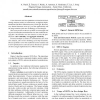Free Online Productivity Tools
i2Speak
i2Symbol
i2OCR
iTex2Img
iWeb2Print
iWeb2Shot
i2Type
iPdf2Split
iPdf2Merge
i2Bopomofo
i2Arabic
i2Style
i2Image
i2PDF
iLatex2Rtf
Sci2ools
DATE
2007
IEEE
2007
IEEE
Use of statistical timing analysis on real designs
A vast literature has been published on Statistical Static Timing Analysis (SSTA), its motivations, its different implementations and their runtime/accuracy trade-offs. However, very limited literature exists ([1]) on the applicability and the usage models of this new technology on real designs. This work focuses on the use of SSTA in real designs and its practical benefits and limitations over the traditional design flow. We introduce two new metrics to drive the optimization: skew criticality and aggregate sensitivity. Practical benefits of SSTA are demonstrated for clock tree analysis, and correct modeling of on-chip-variations. The use of SSTA to cover the traditional corner analysis and to drive optimization is also discussed. Results are reported on three designs implemented on a 90nm technology.
Related Content
| Added | 02 Jun 2010 |
| Updated | 02 Jun 2010 |
| Type | Conference |
| Year | 2007 |
| Where | DATE |
| Authors | A. Nardi, Emre Tuncer, S. Naidu, A. Antonau, S. Gradinaru, Tao Lin, J. Song |
Comments (0)

